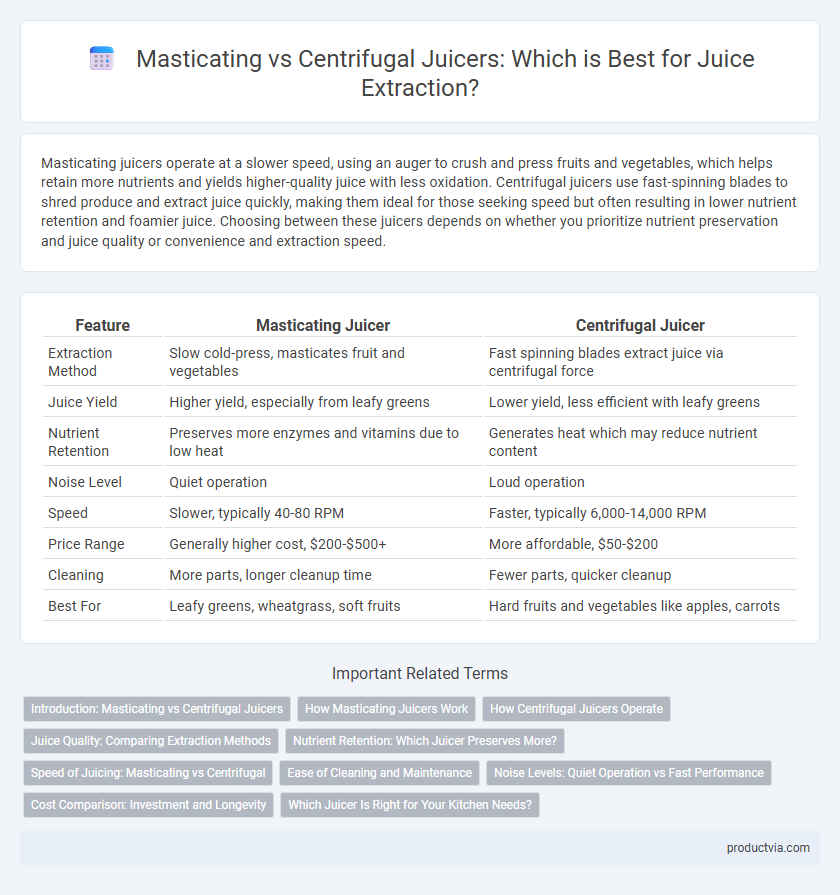Masticating juicers operate at a slower speed, using an auger to crush and press fruits and vegetables, which helps retain more nutrients and yields higher-quality juice with less oxidation. Centrifugal juicers use fast-spinning blades to shred produce and extract juice quickly, making them ideal for those seeking speed but often resulting in lower nutrient retention and foamier juice. Choosing between these juicers depends on whether you prioritize nutrient preservation and juice quality or convenience and extraction speed.
Table of Comparison
| Feature | Masticating Juicer | Centrifugal Juicer |
|---|---|---|
| Extraction Method | Slow cold-press, masticates fruit and vegetables | Fast spinning blades extract juice via centrifugal force |
| Juice Yield | Higher yield, especially from leafy greens | Lower yield, less efficient with leafy greens |
| Nutrient Retention | Preserves more enzymes and vitamins due to low heat | Generates heat which may reduce nutrient content |
| Noise Level | Quiet operation | Loud operation |
| Speed | Slower, typically 40-80 RPM | Faster, typically 6,000-14,000 RPM |
| Price Range | Generally higher cost, $200-$500+ | More affordable, $50-$200 |
| Cleaning | More parts, longer cleanup time | Fewer parts, quicker cleanup |
| Best For | Leafy greens, wheatgrass, soft fruits | Hard fruits and vegetables like apples, carrots |
Introduction: Masticating vs Centrifugal Juicers
Masticating juicers operate at low speeds, using an auger to crush and press fruits and vegetables, preserving more nutrients and yielding higher juice quality compared to centrifugal juicers. Centrifugal juicers utilize high-speed spinning blades to shred produce, extracting juice quickly but often introducing more oxidation and foam. Choosing between masticating and centrifugal juicers depends on factors like juice yield, nutrient retention, noise levels, and ease of cleaning.
How Masticating Juicers Work
Masticating juicers operate by slowly crushing and grinding fruits and vegetables to extract juice, preserving maximum nutrients and enzymes. Their slow auger mechanism minimizes heat buildup and oxidation, resulting in higher-quality juice with better flavor and longer shelf life compared to centrifugal juicers. This method is particularly effective for leafy greens, wheatgrass, and soft fruits, ensuring efficient extraction and minimal pulp.
How Centrifugal Juicers Operate
Centrifugal juicers operate by using a rapidly spinning metal blade to shred fruits and vegetables, extracting juice through centrifugal force. The high-speed spinning separates juice from the pulp via a mesh filter, delivering fast juice extraction suitable for hard and watery produce. However, this method may introduce heat and oxidation, which can reduce nutrient retention compared to slower masticating juicers.
Juice Quality: Comparing Extraction Methods
Masticating juicers use slow, cold-press extraction that preserves nutrients and enzymes, resulting in higher juice quality and longer shelf life compared to centrifugal juicers. Centrifugal juicers operate at high speeds, generating heat and oxidation that can degrade nutrients and reduce juice freshness. For optimal nutrient retention and richer flavor, masticating juicers offer superior juice quality over centrifugal models.
Nutrient Retention: Which Juicer Preserves More?
Masticating juicers operate at slower speeds, minimizing heat and oxidation, which significantly enhances nutrient retention in juice compared to centrifugal juicers. Centrifugal juicers spin at high speeds, generating heat that can degrade enzymes and reduce vitamin content. Studies show masticating juicers preserve higher levels of antioxidants, vitamins C and A, and enzymes, making them superior for nutrient-rich juice extraction.
Speed of Juicing: Masticating vs Centrifugal
Centrifugal juicers operate at high speeds, typically around 6,000 to 14,000 RPM, allowing them to extract juice quickly and efficiently, making them ideal for users seeking fast preparation. Masticating juicers run at much slower speeds, usually between 40 to 80 RPM, which minimizes heat and oxidation but results in a longer juicing process. This slower speed helps preserve more nutrients and enzymes, favoring those who prioritize juice quality over speed.
Ease of Cleaning and Maintenance
Masticating juicers are generally easier to clean due to fewer parts and slower operation, which reduces pulp buildup and simplifies rinsing. Centrifugal juicers typically require more thorough cleaning because their high-speed blades create fine pulp that can clog filters and hard-to-reach spaces. Choosing a juicer with dishwasher-safe components can further streamline maintenance and enhance user convenience.
Noise Levels: Quiet Operation vs Fast Performance
Masticating juicers operate at low speeds, producing minimal noise ideal for quiet environments, whereas centrifugal juicers run at high speeds, generating louder noise but delivering faster juice extraction. The quiet operation of masticating juicers preserves nutrient quality by reducing heat buildup during slow crushing. Centrifugal juicers offer rapid performance suitable for busy routines but may sacrifice noise comfort and nutrient retention due to high-speed blade action.
Cost Comparison: Investment and Longevity
Masticating juicers generally demand a higher initial investment, ranging from $200 to $400, while centrifugal models are more affordable, typically priced between $50 and $150. Despite the upfront cost, masticating juicers offer superior longevity due to their slower, gentler extraction process that reduces wear and tear on components. Over time, the durability and efficiency of masticating juicers can provide better value compared to the shorter lifespan and more frequent replacements associated with centrifugal juicers.
Which Juicer Is Right for Your Kitchen Needs?
Masticating juicers extract juice by slowly crushing and pressing fruits and vegetables, preserving maximum nutrients and yielding higher juice quality, ideal for those prioritizing health and nutrient retention. Centrifugal juicers use high-speed spinning blades that quickly separate juice from pulp, making them suitable for users seeking faster juice preparation and easy cleanup. Choosing the right juicer depends on your kitchen needs--opt for masticating models for nutrient-dense juices and slower, quieter operation, or centrifugal juicers for speed and efficiency in everyday use.
Masticating vs Centrifugal for juice extraction Infographic

 productvia.com
productvia.com